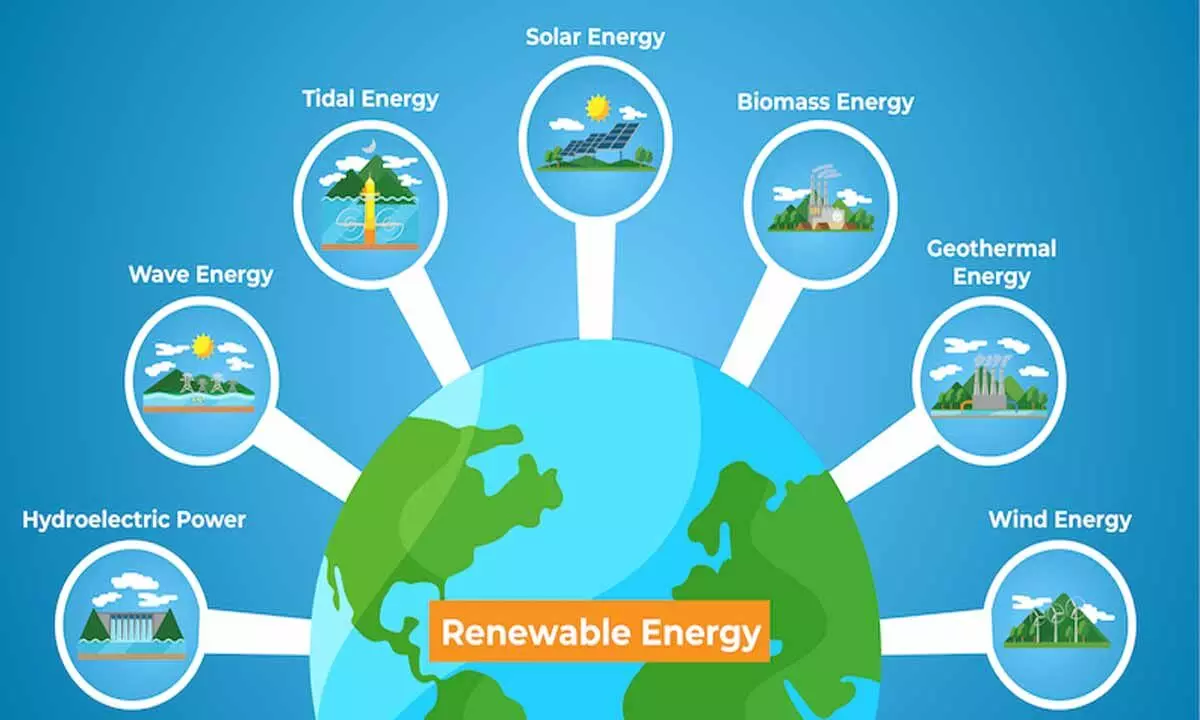Thrust on renewable energy will usher in a healthy tomorrow
Sources are aplenty but their potential is not being harnessed to appropriate levels
image for illustrative purpose

Cheap electricity from renewable sources could provide 65 per cent of the world’s total electricity supply by 2030. It could decarbonize 90 per cent of the power sector by 2050, massively cutting carbon emissions and helping to mitigate climate change. Although solar and wind power costs are expected to remain higher than the pre-pandemic levels due to general elevated commodity and freight prices, their competitiveness actually improves due to much sharper increases in gas and coal prices, says the International Energy Agency
A large chunk of the greenhouse gases that blanket the earth and trap sun’s heat are generated through energy production, by burning fossil fuels for generating electricity and heat.
Fossil fuels, such as coal, oil and gas, are by far the largest contributor to global climate change, accounting for over 75 per cent of global greenhouse gas emissions and nearly 90 per cent of all carbon dioxide emissions.
Science is clear on this issue: in order to avoid the worst impacts of climate change, emissions need to be reduced by almost half by 2030 and reach net-zero by 2050.
To achieve this, we need to end our reliance on fossil fuels and invest in alternative sources of energy that are clean, accessible, affordable, sustainable and reliable. Renewable energy sources – which are available in abundance all around us, provided by the sun, wind, water, waste, and heat from the earth – are replenished by nature and emit little to no greenhouse gases or pollutants into the air.
Fossil fuels still account for more than 80 percent of global energy production, but cleaner sources of energy are gaining ground. About 29 per cent of electricity currently comes from renewable sources.
About 80 percent of the global population lives in countries that are net-importers of fossil fuels -- that’s about six billion people who are dependent on fossil fuels from other countries, which makes them vulnerable to geopolitical shocks and crises.
In contrast, renewable energy sources are available in all countries, and their potential is yet to be fully harnessed. The International Renewable Energy Agency (IRENA) estimates that 90 per cent of the world’s electricity can and should come from renewable energy by 2050.
Renewable energy actually is the cheapest power option in most parts of the world today. Prices for renewable energy technologies are dropping rapidly. The cost of electricity from solar power fell by 85 per cent between 2010 and 2020. Costs of onshore and offshore wind energy fell by 56 per cent and 48 per cent, respectively.
Cheap electricity from renewable sources could provide 65 per cent of the world’s total electricity supply by 2030. It could decarbonize 90 per cent of the power sector by 2050, massively cutting carbon emissions and helping to mitigate climate change.
Although solar and wind power costs are expected to remain higher than the pre-pandemic levels due to general elevated commodity and freight prices, their competitiveness actually improves due to much sharper increases in gas and coal prices, says the International Energy Agency (IEA).
According to the World Health Organization (WHO), about 99 per cent of people in the world breathe air that exceeds air quality limits and threatens their health, and more than 13 million deaths around the world each year are due to avoidable environmental causes, including air pollution. The unhealthy levels of fine particulate matter and nitrogen dioxide originate mainly from the burning of fossil fuels. In 2018, air pollution from fossil fuels caused $2.9 trillion in health and economic costs, about $8 billion a day. Switching to clean sources of energy, such as wind and solar, thus helps address not only climate change but also air pollution and health.
Every dollar of investment in renewables creates three times more jobs than that in the fossil fuel industry. IEA estimates that the transition towards net-zero emissions will lead to an overall increase in energy sector jobs: while about five million jobs in fossil fuel production could be lost by 2030, an estimated 14 million new jobs would be created in clean energy, resulting in a net gain of nine million jobs. In addition, energy-related industries would require a further 16 million workers, for instance to take on new roles in manufacturing of electric vehicles and hyper-efficient appliances or to handle innovative technologies such as hydrogen. This means that a total of more than 30 million jobs could be created in clean energy, efficiency, and low-emissions technologies by 2030.
About $5.9 trillion was spent on subsidizing the fossil fuel industry in 2020, including through explicit subsidies, tax breaks and health and environmental damages that were not priced into the cost of fossil fuels.
In comparison, about $4 trillion a year needs to be invested in renewable energy until 2030 – including investments in technology and infrastructure – to help attain net-zero emissions by 2050.
The upfront cost can be daunting for many countries with limited resources, and many will need financial and technical support to make the transition. But investments in renewable energy will pay off. The reduction of pollution and climate impacts alone could save the world up to $4.2 trillion per year by 2030.

